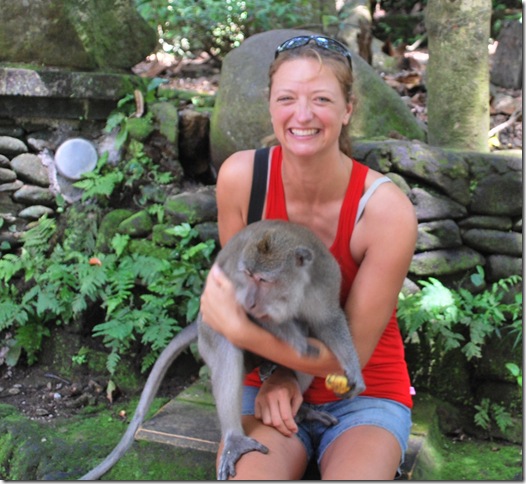Ubud is famous for being the spiritual, cultural and artistic center of Bali. In addition to being a tourist destination, it also seems to be home to a fair number of expats with a disproportionately large number of them being keenly interested in yoga, meditation, tantric breathing, baggy clothes in earth tones, organic foods, dog shelters, etc. I can’t really poke fun at all the upscale culturally sensitive Westerners there since I’m a vegetarian whose wife enjoys yoga (it is pretty cool to watch) and I was also interested in visiting Ubud (and who doesn’t love dogs), but it is an interesting crowd that we really haven’t seen much of on our travels.
We’ve taken in a traditional dance performance at nearly every country we’ve visited, and it was at the top of our Ubud to-do list. Without really knowing anything about the layout of Ubud we managed to drive into town and park right across from a temple that was starting a traditional dance performance show in 15 minutes. We bought a couple of tickets, found some gelato to stave off our hunger for another hour or so and then took our seats in the temple. In case it’s not clear from the pictures, the temples here come in a few different flavors, but a common one is a stone construction featuring a large rectangular space with a raised floor that is open on three sides, pillars holding up a red tile roof, and an ornate facade at the back of the temple behind a stage-like area. In this case, we sat on chairs in the large open space while the show was on the stage. The left and right sides of the stage were filled with musicians making up a sort of small orchestra. With the exception of one flute player and four female singers, all of them played some type of percussion instrument. There were drums and gongs, bell-like instruments, Balinese xylophones, and a simple wooden percussion instrument player that seemed to be keeping the main rhythm for the whole affair. At times it sounded pretty good, but most of the time it sounded like a cacophony bordering on chaos. I guess it’s an acquired taste. Either way, the skill of the musicians was pretty impressive. They probably do this twice a week, but they played for nearly two hours without a single piece of written music, no director waving hands and arms in front of them, and didn’t seem to ever miss a note. Often the guys playing the most difficult and quick pieces on the more complex instruments would be looking off into the distance with an expressionless face while the little carved hammer in their right hand flew over the top of the instrument, striking it at different angles in perfect time with the other players beside them.
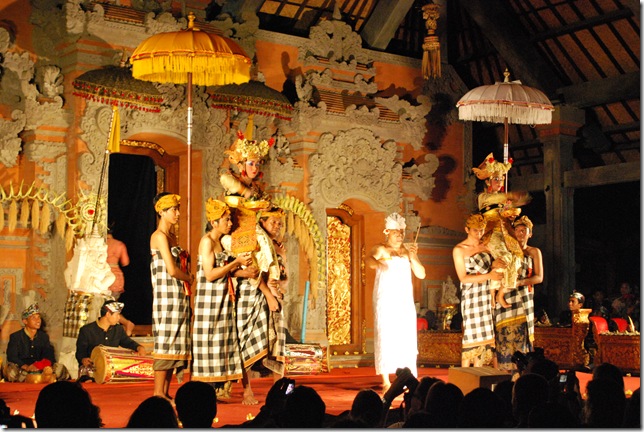 You know you’ve arrived when you have two guys to carry you and one to hold your umbrella
You know you’ve arrived when you have two guys to carry you and one to hold your umbrella
I wish I could say as much for the dancing and acting. At least the costumes were colorful and entertaining. It seems like if you’re a participant playing a demon or some other role that involves a mask then you get to dance around like a jester and try to mime the storyline. The dancers that didn’t wear masks generally had very slow motions featuring lots of hand and arm contortions, strictly defined poses, slow turns of the head to particular angles, etc. The first dance featured two female dancers whose movements weren’t too entertaining, but the degree to which they stayed synchronized in their motion was pretty impressive, especially considering the complex and arrhythmic sounds from the orchestra as well as the fact that they often had their eyes closed or weren’t facing each other. Lauren is the official dance critic (I often catch her making breakfast with her legs in some sort of a dance pose) and she wasn’t impressed either. Maybe we’re just spoiled by the simple, emotive Polynesian dances or maybe it’s the stereotypical Asian restraint in terms of self-expression. There’s no doubt that the Balinese society is much more modernized, developed, and complex than the indigenous societies of the Pacific Islands, but the Legong dance wasn’t our favorite example.
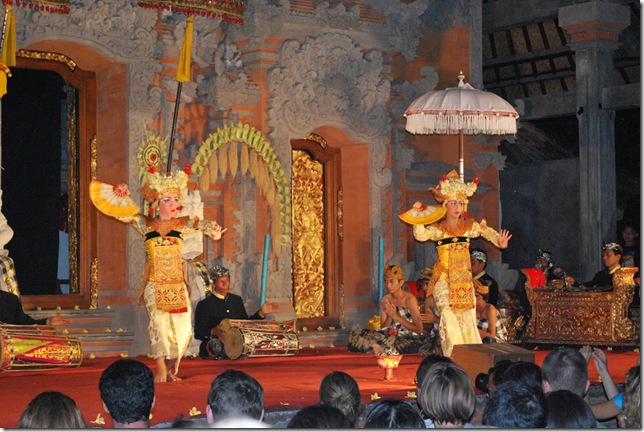 At least the costumes were great
At least the costumes were great
We were pretty tired after driving the scooter halfway across Bali so we found a basic warung dinner and a nearby hotel. The hotel was just the first one we stopped at and aside from not having any electricity in our room much of the time it was pretty amazing. It was part of a family compound in the city that had several rooms built in different styles in a small three-story space. It felt something like a monastery with the stone stairs, decorative wooden doors, and small space, but each room was spacious and had a patio for enjoying breakfast. On the way in you walked past the partially open-walled rooms of the family that owned and ran the hotel. In the morning the family spaces were full of friends and relatives with large bowls of food and plenty of drinks to celebrate some sort of ceremony. It was so laid back that they didn’t bother to ask about money, name, or ID when we walked in and when I asked about breakfast they said it was “from 7am to whenever you get up.” The family compound with an onsite business was a theme in Ubud; we saw several beautiful ones as we walked one of the main streets looking at the variety of art – paintings, wood carvings, weavings, silver jewelry and crafts.
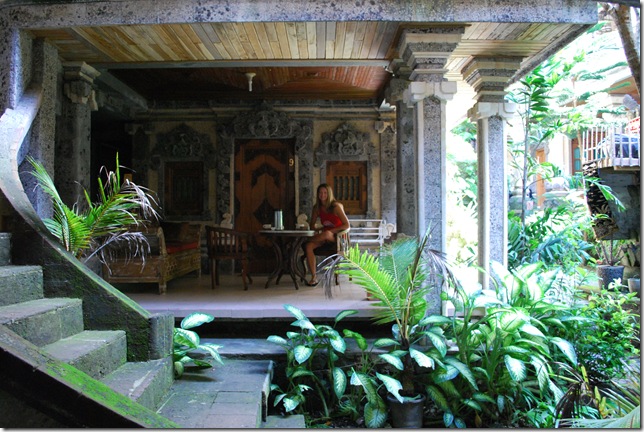 $20/night is a bit steep, but it looks great
$20/night is a bit steep, but it looks great
At the end of the street, aptly named Monkey Forest Road, we came to the Sacred Monkey Forest Sanctuary. The Monkey Forest is basically a small jungle area in the midst of an otherwise populated region where there are several temples and three troops of Balinese macaque monkeys. We bought some bananas to feed the monkeys and read that we weren’t to give the bananas directly to them, but to set them down for the monkeys to come and get. Apparently the monkeys haven’t read the brochure at the front desk. We were barely 10 paces down the forest path when a reasonably sized monkey spotted Lauren and her bunch of bananas. He strode quickly and smoothly toward her and then climbed up her leg and torso to grab a banana from her hand. She managed to stay pretty calm and only let out a couple of yells as the monkey darted to the edge of the path to chomp away. This scene was repeated several times. One of the trained monkey guardians actually had Lauren sit down and hold a banana up in one hand so the monkey would climb over her and onto her shoulder to take the banana. It all worked according to plan until the monkey came down off of her shoulder and into her lap on its way down. Being one of the sweetest and affectionate people around, and with a soft, furry monkey walking across her lap, Lauren just couldn’t resist the impulse to hug it. As she started to put her arm around it, the guardian yelled “Don’t touch monkey!”, startling both Lauren and the monkey, which had no intent of hanging around to snuggle. It took a while to stop laughing. I guess I was one up on all the tree-hugger types visiting Ubud; I came with my wife Lauren the great white monkey-hugger.
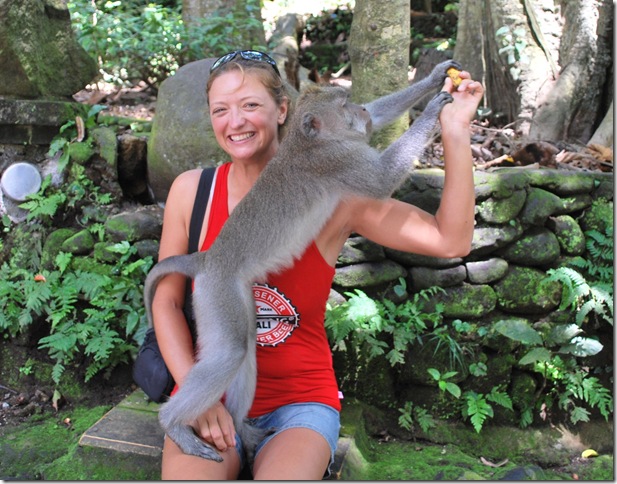 Little does this sweet little monkey suspect…
Little does this sweet little monkey suspect…
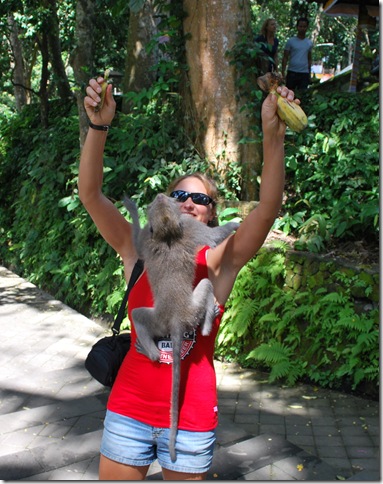 Ferns and banyan tree in background, monkey climbing banana tree in foreground
Ferns and banyan tree in background, monkey climbing banana tree in foreground
After several more episodes of monkeys climbing Lauren a.k.a. The Banana Tree, we started off on a walk through several villages and the countryside that was outlined in the Lonely Planet book. The walk was a great opportunity to see local villages, painters and wood carvers at work, and rice paddies in several states of maturity, from small shoots through to just-harvested stalks and plowed-under fields. We even came across a duck herder. I have no idea what the relationship between the villagers, the ducks, and the rice paddies is (aside from ducks eat stuff from the paddies and villagers eat ducks), but we came across a guy holding a long bamboo pole with plastic bags tied at one end. He was walking slowly through a rice paddy herding a large group of ducks, separating them into two groups and then moving one group across the road to another paddy. The ducks were some species of mallard and had either had their wings clipped so they couldn’t fly or were just used to being herded around. After another incredible dinner for less than $2/plate we found a room in a family compound nestled among the rice paddies at the edge of town. It didn’t look like much from a distance, but it was actually the nicest place we’ve stayed and had hot water as well.
We decided to give Balinese traditional dance one more try and went to a performance of the Kecak (KAY-chack) or Monkey Dance, which is a popular tourist attraction. This one was also on temple grounds, but outdoors in a circle on a large stone courtyard. The dance is a traditional story of love and war with the twist that the story features a large army of monkeys. The monkey army is represented by more than 50 men wearing a black and white checkered wrap with a red belt wrap. For most of the dance they sit in rows that form several concentric circles, although at times they stand, lay down, raise their arms, rock side to side, or move into different formations. A couple of the older men lead the chanting and singing. For most of the dance and play, which lasts more than 30 minutes, they make a the sound “chak-chak-chak” in unison — “chak-chak-chak-chak chak-chak-chak-chak chak-chak-chak-chak chak-a-chak”. You get the idea. Even though the dancing and acting were the same style and quality as the Legong dance, the Kecak was done around a firelight and to hear all the men chant and sing together makes a lasting impression.
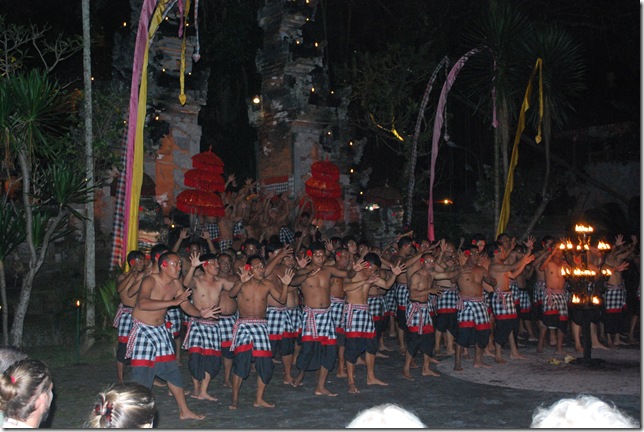 Kecak dancers entering the courtyard
Kecak dancers entering the courtyard
 Most of the Kecak dance/play was done with the men in a circle
Most of the Kecak dance/play was done with the men in a circle
After the Kecak dance, we were treated to a special horse trance fire dance. We didn’t really know what to expect, but figured it would be something like fire twirling dances in the Pacific. First the fires for the Kecak dance were put out and all the men formed several lines in the back of the open area. Then a man came out in the dark with a large box on a cart and dumped what sounded like a large pile of coconuts onto stone courtyard. A few seconds later he came back with a bottle of kerosene, poured it over the pile and then lit it on fire. We could now see that it was coconut husks and soon afterward a man came out dressed like the Kecak dancers but wearing a large hobby-horse contraption that fit over his shoulder and between his legs. He began to dance over the stone courtyard with his eyes closed. The left half of the men sang and chanted something similar to the Kecak song and chant and then the men on the right started to sing a different song. When the group of men on the right started singing, the barefoot hobby horse dancer turned and ran straight into the pile of burning coconut husks, kicking the glowing husks all over the courtyard, some landing only inches from the tourists in the front row! Needless to say, this got everyone’s attention. Two men came out with a wooden rakes and pushed the scattered and glowing husks back into a pile as the left group of men chanted. When the right group of men began to sing, the dancer again ran into the glowing pile of husks and kicked and scattered them. This was repeated a number of times before two men came out and caught the dancer, wrestling him to the ground and pulling the hobby horse contraption off of him. As soon as the horse was pulled off of him, the man collapsed in a seated position, a priest came out to sprinkle him with some water and he started praying. He was still sitting there with outstretched, blackened feet as we filed out of the temple grounds.
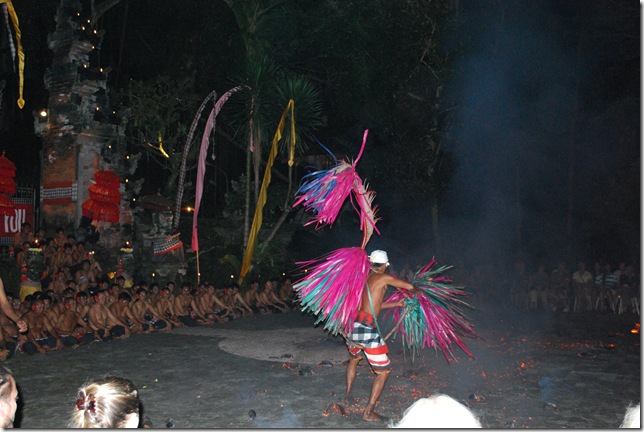 Fire dancer kicking and scattering the burning coconut husks
Fire dancer kicking and scattering the burning coconut husks


